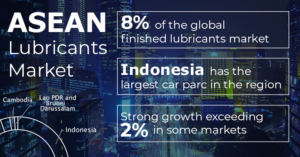
The Association of Southeast Asian Nations (ASEAN) is a cooperation among 10 countries (Brunei Darussalam, Cambodia, Indonesia, Lao PDR, Malaysia, Myanmar, the Philippines, Singapore, Thailand, and Vietnam) for promoting regional economic and social development. The region has some of the fastest-growing economies, where service and agriculture sectors are important contributors to gross domestic products. Within the agriculture sector, palm oil and natural rubber products are important export commodities. Countries like Thailand, Indonesia, and Malaysia are important automotive manufacturing centers, and Singapore is an important trade hub.
The region is estimated to account for about 8% of the global finished lubricants market, estimated at 41 million tonnes in 2019. In comparison to western countries, lubricants consumers are very price-sensitive, especially in the commercial automotive segment, where use of monograde is still ongoing. Low-quality, mineral-oil-based lubricants are still used in the region and are being sold by local suppliers. Kline’s report, Opportunities in Lubricants: ASEAN Market Analysis, covers lubricants markets of eight major countries in the region: Cambodia, Indonesia, Lao PDR, Malaysia, Myanmar, Thailand, the Philippines, and Vietnam.
Estimated Finished Lubricants Demand in ASEAN by Country, 2019
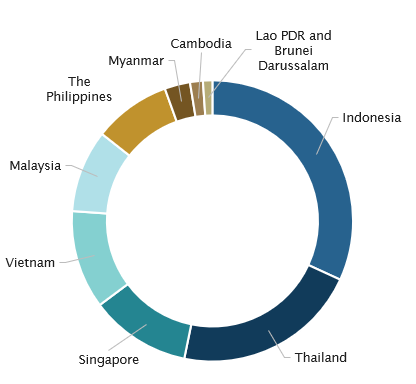
Total: 3,100 KT
Overall demand for lubricants in ASEAN was estimated at slightly more than 3,100 kilotonnes in 2019. Indonesia accounted for about one-third of the regional lubricants demand due to its largest vehicle parc and large industrial sector. Thailand followed with a share of slightly more than one-fifth of the overall regional demand in 2019. Thailand’s lubricants market is very competitive, with 150 to 170 brands. Singapore was the third-largest market due to its huge appetite for marine lubricants. If marine lubricants are excluded, Singapore’s demand for lubricants will be close to that of Cambodia. The lubricants market in Lao PDR and Cambodia are import-driven, with no significant indigenous capacity for lubricants blending. Even in Myanmar, lubricants demand is mostly fulfilled by foreign suppliers.
Estimated Finished Lubricants Demand in ASEAN by Segment, 2019
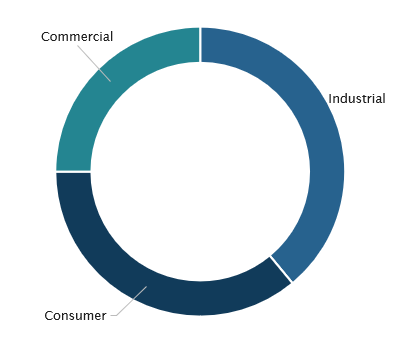
Total: 3,100 KT
Automotive lubricants accounted for a larger share than industrial lubricants because the region is not as industrialized as western countries. Countries such as Cambodia, Lao PDR, and Myanmar do not have a well-developed manufacturing sector, and their agriculture sector is also not as mechanized as in other parts of the world. Cambodia and Lao PDR do not have an automotive manufacturing base but only a few assembly plants and are largely import driven markets. Myanmar has limited production of passenger cars and commercial vehicles. Indonesia, Thailand, Malaysia, and Vietnam are considered relatively more industrialized than Cambodia, Lao PDR, and Myanmar. Thailand is the largest automotive producer in ASEAN. The Philippines is primarily considered a newly industrialized country, which has an economy in transition, from one based on agriculture to one based more on services and manufacturing.
On further dividing the automotive segment into consumer and commercial segments, the industrial segment appeared to be the largest because of huge demand for marine lubricants in Singapore. The high population of two-wheelers in this region explains why the consumer automotive lubricants segment had a higher share than the commercial automotive lubricants segment.
The total vehicle parc in select ASEAN countries was estimated to range between 250 million and 300 million units in 2019. Indonesia had the largest vehicle population among ASEAN members, and it represented one of the largest two-wheeler markets in the world. Two-wheelers are a key mode of transportation for the lower- and middle-class population across various developing Asian countries. These vehicles are not only used for personal use but also by businesses for providing services such as food delivery, transportation and courier services. In most countries, the population of two-wheelers is more than that of passenger cars, but in Malaysia, the car population exceeds that of two-wheelers.
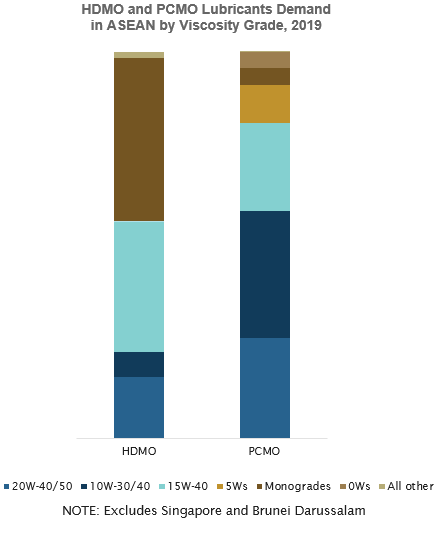 In the commercial segment, monogrades accounted for a significant share of total heavy-duty motor oils (HDMO) demand in the eight ASEAN countries in 2019. The old on-highway vehicles, as well as off-highway equipment, are responsible for the significant penetration of monogrades. The most popular viscosity grades of multigrade HDMO in use in 2019 were 15W-40, followed by 20W-40/50 and 10W-30/10W-40. Among these, the leading viscosity grade was 15W-40, but in recent years, commercial vehicle OEMs have started recommending 10W-30/40 for their new vehicle models.
In the commercial segment, monogrades accounted for a significant share of total heavy-duty motor oils (HDMO) demand in the eight ASEAN countries in 2019. The old on-highway vehicles, as well as off-highway equipment, are responsible for the significant penetration of monogrades. The most popular viscosity grades of multigrade HDMO in use in 2019 were 15W-40, followed by 20W-40/50 and 10W-30/10W-40. Among these, the leading viscosity grade was 15W-40, but in recent years, commercial vehicle OEMs have started recommending 10W-30/40 for their new vehicle models.
Unlike the commercial segment, demand for multigrades accounted for a higher share than monogrades in the consumer automotive segment. However, monogrades are not eliminated from the market and have significant shares in country markets such as Indonesia, Cambodia, Myanmar, and Lao PDR. The largest viscosity grade category included 10W-30 and 10W-40. Demand for lower viscosity grades such as 5Ws and 0Ws has improved in this region. 0Ws are a niche category and have noteworthy demand in Indonesia, Thailand, and Malaysia, the three largest PCMO consumers in the region.
Industrial Lubricants Demand in ASEAN by Product Type, 2019
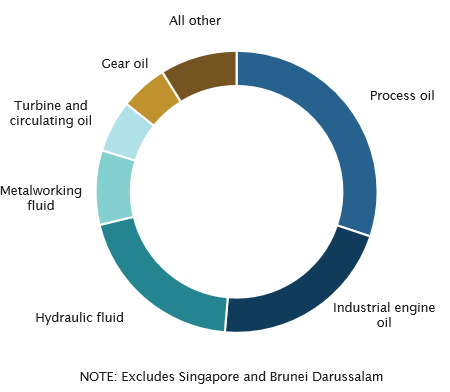
Process oil was the largest industrial oil category in the major ASEAN countries in 2019. High demand for process oil is essentially due to a large demand for rubber process oils in Indonesia, Malaysia, and Thailand. Process oil is followed by industrial engine oil, which is closely followed by hydraulic fluids. A large part of industrial engine oil is constituted by marine engine oil, which has high demand in Indonesia, Thailand, and the Philippines. It is also the largest engine oil type in Cambodia and Myanmar. The most significant demand for metalworking fluids comes from Thailand, where a considerable percentage of this demand is coming from transportation equipment manufacturing.
The overall lubricants demand in the select countries in ASEAN is expected to grow at a moderate compound annual growth rate (CAGR) of 2.0% from 2019 to 2029. The growth rate is expected to be higher for the period 2024 to 2029 as the economies would have recovered from COVID-19’s negative impact by 2024; after that, industrialization and urbanization will pick up momentum. COVID-19, which caused prolonged lockdowns, has the ability to push the lubricants market downward by 7% to 17% in 2020 in comparison to the demand in 2019.
Lubricants Demand Forecast in ASEAN by Country, 2019 - 2029
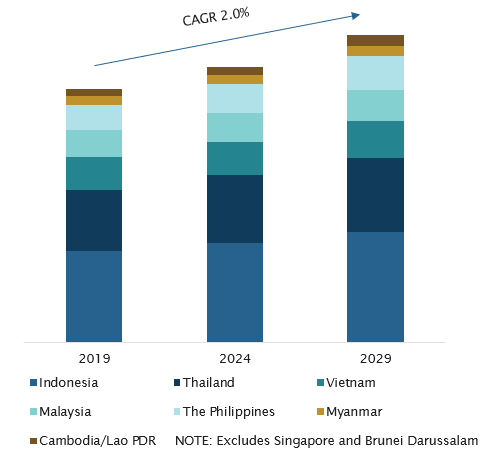
Despite a major setback due to the pandemic, the lubricants market in this region is very dynamic and presents strong growth prospects over the forecast period. Growth is expected to be driven by the consumer segment, followed by the commercial and industrial segments. Growing population and urbanization in the key countries will fuel passenger vehicle parc growth. In many countries, the popularity of two-wheelers will also contribute to the stronger growth in the segment. Government regulations and policies, COVID-19’s impact in the short term, consumer purchasing power, government spending on key industries, and international trade and commodity prices are some of the factors that can critically impact industrial and commercial automotive lubricants segments over the forecast period.
The insights from this study are sourced from Kline’s report, Opportunities in Lubricants: ASEAN Market Analysis published October, 2020. To learn more about this market, REGISTER for the upcoming free WEBINAR.
Also, check out studies covering other regions:
Opportunities in Lubricants: Latin America and Caribbean Market Analysis REQUEST WEBINAR RECORDING >>
Opportunities in Lubricants: Middle East Market Analysis REGISTER FOR A WEBINAR >>
[pardot-form id="15031" title="ACTION REQUIRED Energy COVID-19 Impact on Lube Markets INQUIRY"]

